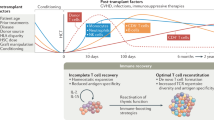Abstract
EVIDENCE exists indicating that functionally different subsets of T lymphocytes are activated during the in vitro allograft response. Thus, the T cells responding primarily by proliferation in the mixed lymphocyte culture (MLC) may be distinct from the T cells which differentiate to killer cells and display specific target cell lysis (CML)1–3. The biological properties of the T-cell subsets involved are incompletely known. Adult thymectomy (ATX) in mice and rats alters certain T lymphocyte mediated functions. Spleen T cells forming rosettes with sheep erythrocytes disappear as soon as 5 d after ATX4,5. Lymphocyte with high amounts of surface θ antigen are depleted from the spleen within a few weeks after the operation (Ref. 6 and C. Fournier and J. F. B., unpublished).
This is a preview of subscription content, access via your institution
Access options
Subscribe to this journal
Receive 51 print issues and online access
$199.00 per year
only $3.90 per issue
Buy this article
- Purchase on Springer Link
- Instant access to full article PDF
Prices may be subject to local taxes which are calculated during checkout
Similar content being viewed by others
References
Wagner, H., Rollinghöf, M., and Nossal, G., Transpln Rev., 17, 4 (1973).
Cohen, L., and Howe, N. L., Proc. natn. Acad. Sci. U.S.A., 70, 2707 (1973).
Häyry, P., and Andersson, L. C., Eur. J. Immun., 4, 145 (1974).
Bach, J. F., Dardenne, M., and Davies, A. J. S., Nature new Biol., 231, 110 (1971).
Bach, J. F., and Dardenne, M., Cell. Immun., 6, 394 (1974).
Schlesinger, M., and Yron, I., J. Immun., 104, 798 (1972).
Bach, J. F., Dardenne, M., and Bach, M. A., Ann. N. Y. Acad. Sci., (in the press).
Häyry, P., Andersson, L. C., Nordling, S., and Virolainen, M., Transpln Rev., 12, 91 (1972).
Julius, M. H., Simpson, E., and Herzenberg, L. A., Eur. J Immun., 3, 645 (1973).
Andersson, L. C., Nordling, S., and Häyry, P., J. exp. Med., 138, 324 (1973).
Andersson, L. V., Nordling, S., and Häyry, P., Scand. J. Immun., 2, 107 (1973).
Brunner, K. T., Mauel, J., Cerottini, J. C., and Chapuis, B., Immunology, 14, 181 (1968).
Bach, M. A., and Bach, J. F., Transpln Proc., 4, 165 (1972).
Schwarz, R., and Robson, L. C., Transplantation, 11, 465 (1971).
Folch, H., and Waksman, B., J. Immun., 5, 1046 (1972).
Howe, M., and Cohen, L., in Proc. 8th Leukocyte Culture Conf., (edit. by Lindahl-Kiessling, K., and Osoba, D.),611 (Academic Press, New York, 1974).
Author information
Authors and Affiliations
Rights and permissions
About this article
Cite this article
ANDERSSON, L., HÄYRY, P., BACH, M. et al. Differences in the effects of adult thymectomy on T-cell mediated responses in vitro. Nature 252, 252–254 (1974). https://doi.org/10.1038/252252b0
Received:
Issue Date:
DOI: https://doi.org/10.1038/252252b0
This article is cited by
-
Temporal changes of suppressor T lymphocytes and cytotoxic T lymphocytes in syngeneic murine malignant gliomas
Journal of Neuro-Oncology (1986)
-
Changes in human T lymphocytes after thymectomy and during senescence
Journal of Clinical Immunology (1982)
-
Cytotoxic responses to alloantigens in systemic lupus erythematosus
Journal of Clinical Immunology (1981)
-
Splenic T-killer cells can be generated by allogeneic thymic cells in conjunction with assisting factor
Nature (1977)
-
Soluble factors substitute for T–T-cell collaboration in generation of T-killer lymphocytes
Nature (1976)
Comments
By submitting a comment you agree to abide by our Terms and Community Guidelines. If you find something abusive or that does not comply with our terms or guidelines please flag it as inappropriate.



